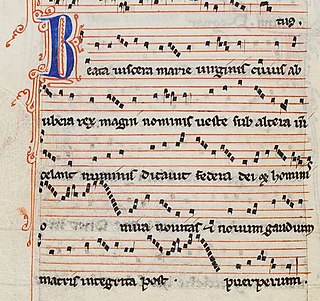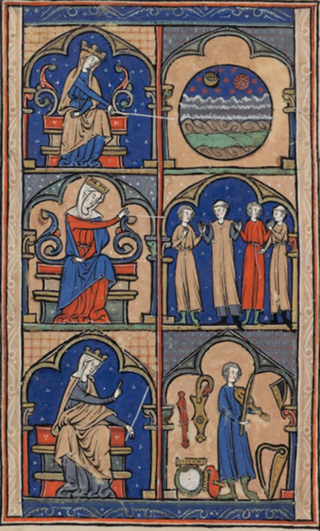
Medieval music encompasses the sacred and secular music of Western Europe during the Middle Ages, from approximately the 6th to 15th centuries. It is the first and longest major era of Western classical music and followed by the Renaissance music; the two eras comprise what musicologists generally term as early music, preceding the common practice period. Following the traditional division of the Middle Ages, medieval music can be divided into Early (500–1150), High (1000–1300), and Late (1300–1400) medieval music.
Pérotin was a composer associated with the Notre Dame school of polyphony in Paris and the broader ars antiqua musical style of high medieval music. He is credited with developing the polyphonic practices of his predecessor Léonin, with the introduction of three and four-part harmonies.
Organum is, in general, a plainchant melody with at least one added voice to enhance the harmony, developed in the Middle Ages. Depending on the mode and form of the chant, a supporting bass line may be sung on the same text, the melody may be followed in parallel motion, or a combination of both of these techniques may be employed. As no real independent second voice exists, this is a form of heterophony. In its earliest stages, organum involved two musical voices: a Gregorian chant melody, and the same melody transposed by a consonant interval, usually a perfect fifth or fourth. In these cases the composition often began and ended on a unison, the added voice keeping to the initial tone until the first part has reached a fifth or fourth, from where both voices proceeded in parallel harmony, with the reverse process at the end. Organum was originally improvised; while one singer performed a notated melody, another singer—singing "by ear"—provided the unnotated second melody. Over time, composers began to write added parts that were not just simple transpositions, thus creating true polyphony.
Léonin was the first known significant composer of polyphonic organum. He was probably French, probably lived and worked in Paris at the Notre Dame Cathedral and was the earliest member of the Notre Dame school of polyphony and the ars antiqua style who is known by name. The name Léonin is derived from "Leoninus," which is the Latin diminutive of the name Leo; therefore it is likely that Léonin's given French name was Léo.

Ars antiqua, also called ars veterum or ars vetus, is a term used by modern scholars to refer to the Medieval music of Europe during the High Middle Ages, between approximately 1170 and 1310. This covers the period of the Notre-Dame school of polyphony, and the subsequent years which saw the early development of the motet, a highly varied choral musical composition. Usually the term ars antiqua is restricted to sacred (church) or polyphonic music, excluding the secular (non-religious) monophonic songs of the troubadours, and trouvères. Although colloquially the term ars antiqua is used more loosely to mean all European music of the 13th century, and from slightly before.

Anonymous 4 was an American female a cappella quartet, founded in 1986 and based in New York City. Their main performance genre was medieval music, although later they also premiered works by recent composers such as John Tavener and Steve Reich.
The Notre-Dame school or the Notre-Dame school of polyphony refers to the group of composers working at or near the Notre-Dame Cathedral in Paris from about 1160 to 1250, along with the music they produced.
The clausula was a newly composed section of discant inserted into a pre-existing setting of organum. Clausulae flourished in the late twelfth and thirteenth centuries and were associated with the Notre Dame school. The origin of the clausula has long been subject of scholarly debate, as the relationship between clausulae and motets is very complicated. Clausulae eventually became used as substitutes for passages of original plainchant. They occur as melismatic figures based on a single word or syllable within an organum.

The conductus was a sacred Latin song in the Middle Ages, one whose poetry and music were newly composed. It is non-liturgical since its Latin lyric borrows little from previous chants. The conductus was northern French equivalent of the versus, which flourished in Aquitaine. It was originally found in the twelfth-century Aquitanian repertories. But major collections of conducti were preserved in Paris. The conductus typically includes one, two, or three voices. A small number of the conducti are for four voices. Stylistically, the conductus is a type of discant. Its form can be strophic or through-composed form. The genre flourished from the early twelfth century to the middle of thirteenth century. It was one of the principal types of vocal composition of the ars antiqua period of medieval music history.
Franco of Cologne was a German music theorist and possibly a composer. He was one of the most influential theorists of the Late Middle Ages, and was the first to propose an idea which was to transform musical notation permanently: that the duration of any note should be determined by its appearance on the page, and not from context alone. The result was Franconian notation, described most famously in his Ars cantus mensurabilis.
Johannes de Garlandia was a French music theorist of the late ars antiqua period of medieval music. He is known for his work on the first treatise to explore the practice of musical notation of rhythm, De Mensurabili Musica.

In medieval music, the rhythmic modes were set patterns of long and short durations. The value of each note is not determined by the form of the written note, but rather by its position within a group of notes written as a single figure called a ligature, and by the position of the ligature relative to other ligatures. Modal notation was developed by the composers of the Notre Dame school from 1170 to 1250, replacing the even and unmeasured rhythm of early polyphony and plainchant with patterns based on the metric feet of classical poetry, and was the first step towards the development of modern mensural notation. The rhythmic modes of Notre Dame Polyphony were the first coherent system of rhythmic notation developed in Western music since antiquity.

The Magnus Liber or Magnus liber organi, written in Latin, was a repertory of medieval music known as organum. This collection of organum survives today in three major manuscripts. This repertoire was in use by the Notre-Dame school composers working in Paris around the end of the twelfth and beginning of the thirteenth centuries, though it is well agreed upon by scholars that Leonin contributed a bulk of the organum in the repertoire. This large body of repertoire is known from references to a "magnum volumen" by Johannes de Garlandia and to a "Magnus liber organi de graduali et antiphonario pro servitio divino" by the English music theorist known as Anonymous IV. Today it is known only from later manuscripts containing compositions named in Anonymous IV's description. The Magnus Liber is regarded as one of the earliest collections of polyphony.
A descant, discant, or discantus is any of several different things in music, depending on the period in question; etymologically, the word means a voice (cantus) above or removed from others. The Harvard Dictionary of Music states:
Anglicized form of L. discantus and a variant of discant. Throughout the Middle Ages the term was used indiscriminately with other terms, such as descant. In the 17th century it took on special connotations in instrumental practice.
France has a rich music history that was already prominent in Europe as far back as the 10th century. French music originated as a unified style in medieval times, focusing around the Notre-Dame school of composers. This group developed the motet, a specific musical composition. Notable in the high Middle Ages were the troubadours and trouvères soon began touring France, composing and performing many original songs. The styles of ars nova and ars subtilior sprung up in the 14th century, both of which focused on secular songs. As Europe moved into the Renaissance age, the music of France evolved in sophistication. The popularity of French music in the rest of Europe declined slightly, yet the popular chanson and the old motet were further developed during this time. The epicenter of French music moved from Paris to Burgundy, as it followed the Burgundian School of composers. During the Baroque period, music was simplified and restricted due to Calvinist influence. The air de cour then became the primary style of French music, as it was secular and preferred by the royal court.
In music, especially Schenkerian analysis, a voice exchange is the repetition of a contrapuntal passage with the voices' parts exchanged; for instance, the melody of one part appears in a second part and vice versa. It differs from invertible counterpoint in that there is no octave displacement; therefore it always involves some voice crossing. If scored for equal instruments or voices, it may be indistinguishable from a repeat, although because a repeat does not appear in any of the parts, it may make the music more interesting for the musicians. It is a characteristic feature of rounds, although not usually called such.
With regard to early polyphony the term copula has a variety of meanings. At its most basic level, it can be thought of as the linking of notes together to form a melody. "A copula is a rapid, connected discant..." However, it is often considered to be a particular type of polyphonic texture similar to organum, but with modal rhythm. The music theorist Johannes de Garlandia favoured this description of copula. The term refers to music where the lower voice sings long, sustained notes while the higher voices sing faster-moving harmony lines. This style is typical of what is referred to as Notre Dame Polyphony; examples of which can be found in the Magnus Liber Organi. Copula might have implied a strophic construction with much repetition in the various parts, which was characteristic of much of the music written in this idiom. The upper part consists of "antecedent-consequent" phrases, themselves featuring much melodic repetition. The rhythm is notated in copula, unlike in organum. It is, in essence, the "coming together" of these two parts at the cadence that led to the term copula being used, from the Latin meaning "that binds."
De Mensurabili Musica is a musical treatise from the early 13th century and is the first of two treatises traditionally attributed to French music theorist Johannes de Garlandia; the other is de plana musica. De Mensurabili Musica was the first to explain a modal rhythmic system that was already in use at the time: the rhythmic modes. The six rhythmic modes set out by the treatise are all in triple time and are made from combinations of the note values longa (long) and brevis (short) and are given the names trochee, iamb, dactyl, anapest, spondaic and tribrach, although trochee, dactyl and spondaic were much more common. It is evident how influential Garlandia's treatise has been by the number of theorists that have used its ideas. Much of the surviving music of the Notre Dame School from the 13th century is based on the rhythmic modes set out in De Mensurabili Musica.
"Viderunt omnes" is a Gregorian chant based on Psalm XCVII (98), sung as the gradual at the Masses of Christmas Day and historically on its octave, the Feast of the Circumcision. Two of the many settings of the text are famous as being among the earliest pieces of polyphony by known composers, Léonin and Pérotin of the Notre Dame school. Their music, known as organum, adds florid counterpoint to the Gregorian melody of the intonation and verse, portions normally sung by the cantors, the remainder of the chant being sung unchanged by the choir.
12th century in music – 13th century in music – 1300s in music




